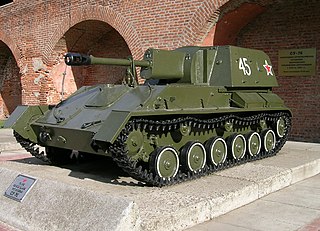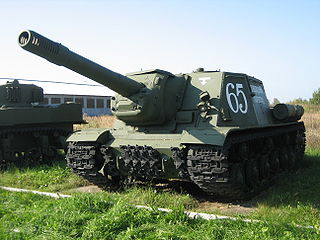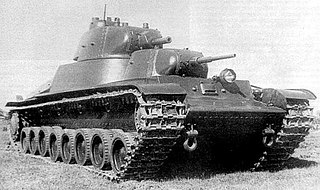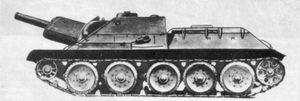
An assault gun is a type of self-propelled artillery which uses an infantry support gun mounted on a motorized chassis, normally an armored fighting vehicle, which are designed to provide direct fire support for infantry attacks, especially against other infantry or fortified positions. Assault guns were pioneered by the Soviet Union and Nazi Germany during the 1930s, initially being self-propelled guns with direct fire in mind, with Germany introducing the first purpose-built assault gun, the Sturmgeschütz III, in 1940.

A tank destroyer, tank hunter or tank killer is a type of armoured fighting vehicle, predominantly intended for anti-tank duties. They are typically armed with a direct fire artillery gun, also known as a self-propelled anti-tank gun, or missile launcher, also called an anti-tank missile carrier. The vehicles are designed specifically to engage and destroy enemy tanks, often with limited operational capacities.

The Kliment Voroshilov (KV) tanks are a series of Soviet heavy tanks named after the Soviet defence commissar and politician Kliment Voroshilov who operated with the Red Army during World War II. The KV tanks were known for their heavy armour protection during the early stages of the war, especially during the first year of the German invasion of the Soviet Union. In certain situations, even a single KV-1 or KV-2 supported by infantry could halt German formations. The German Wehrmacht at that time rarely deployed its tanks against KVs, as their own armament was too poor to deal with the "Russischer Koloss" – "Russian Colossus".

The Panzerkampfwagen III, commonly known as the Panzer III, was a medium tank developed in the 1930s by Germany, and was used extensively in World War II. The official German ordnance designation was Sd.Kfz. 141. It was intended to fight other armoured fighting vehicles and serve alongside and support the similar Panzer IV, which was originally designed for infantry support.

Soviet armoured fighting vehicle production during World War II from the start of the German invasion of the Soviet Union on 22 June 1941 was large. Although the Soviet Union had a large force of combat vehicles before the German invasion, heavy losses led to a high demand for new vehicles. Production was complicated by the loss of production facilities in the western part of the Soviet Union, and entire factories were moved east of the Ural Mountains to put them out of reach of the Germans. In general, Soviet tanks had less interior space than the tanks of other nations – this was possible because the Red Army only employed soldiers of small stature in their tank forces.

The SU-76 was a Soviet light self-propelled gun used during and after World War II. The SU-76 was based on a lengthened version of the T-70 light tank chassis and armed with the ZIS-3 mod. 1942 76-mm divisional field gun. Developed under the leadership of chief designer S.A. Ginzburg (1900–1943). Its quite simple construction and multipurpose combat role made it the second most produced Soviet armored fighting vehicle of World War II, after the T-34 medium tank.

The SU-85 was a Soviet self-propelled gun used during World War II, based on the chassis of the T-34 medium tank. Earlier Soviet self-propelled guns were meant to serve as either assault guns, such as the SU-122, or as tank destroyers; the SU-85 fell into the latter category. The designation "85" means the bore of the vehicle's armament, the 85 mm D-5T gun.

The SU-152 is a Soviet self-propelled heavy howitzer used during World War II.

The ISU-122 was a Soviet assault gun used during World War II, mostly in the anti-tank role.

The ISU-152 is a Soviet self-propelled gun developed and used during World War II. It was unofficially nicknamed Zveroboy in response to several large German tanks and guns coming into service, including Tigers and Panthers. Since the ISU-152's gun was mounted in a casemate, aiming it was awkward, and had to be done by repositioning the entire vehicle using the tracks. Therefore, it was used as mobile artillery to support more mobile infantry and armor attacks. It continued service into the 1970s and was used in several campaigns and countries.

The T-70 is a light tank used by the Red Army during World War II, replacing both the T-60 scout tank for reconnaissance and the T-50 light infantry tank for infantry support. The T-80 light tank was a more advanced version of the T-70 with a two-man turret—it was produced only in very small numbers when light tank production was abandoned. The T-90 self-propelled anti-aircraft gun was a prototype vehicle with twin machine guns, based on the T-70 chassis.

The M10 tank destroyer was an American tank destroyer of World War II. After US entry into World War II and the formation of the Tank Destroyer Force, a suitable vehicle was needed to equip the new battalions. By November 1941, the Army requested a vehicle with a gun in a fully rotating turret after other interim models were criticized for being too poorly designed. The prototype of the M10 was conceived in early 1942 and delivered in April that year. After appropriate changes to the hull and turret were made, the modified version was selected for production in June 1942 as the 3-inch Gun Motor Carriage M10. It mounted a 3-inch gun M7 in a rotating turret on a modified M4 Sherman tank chassis. An alternate model, the M10A1, which used the M4A3 variant chassis, was also produced. Production of the two models ran from September 1942 to December 1943 and October 1942 to November 1943, respectively.

The T-60 scout tank was a light tank produced by the Soviet Union from 1941 to 1942. During this period, 6,292 units were built. The tank was designed to replace the obsolete T-38 amphibious scout tank and saw action during World War II.

The T-34 medium tank is one of the most-produced and longest-lived tanks of all time.

The 122 mm howitzer M1938 (M-30) is a Soviet 121.92 mm (4.8 inch) howitzer. The weapon was developed by the design bureau of Motovilikha Plants, headed by F. F. Petrov, in the late 1930s, and was in production from 1939 to 1955. The M-30 saw action in World War II, mainly as a divisional artillery piece of the Red Army (RKKA). Captured guns were also employed later in the conflict by the German Wehrmacht and the Finnish Army. Post World War II the M-30 saw combat in numerous conflicts of the mid- to late twentieth century in service of other countries' armies, notably in the Middle East.

The 85 mm air defense gun M1939 (52-K) was an 85 mm (3.3 in) Soviet anti-aircraft gun, developed under guidance of leading Soviet designers M. N. Loginov and G. D. Dorokhin. This gun was successfully used throughout the Second World War against level bombers and other high- and medium-altitude targets. In emergencies they were utilized as powerful anti-tank weapons. The barrel of the 52-K was the basis for the family of 85-mm Soviet tank guns. After the war some 52-Ks were refitted for peaceful purposes as anti-avalanche guns in mountainous terrain.
Samohodnaya Ustanovka may refer to any of these Soviet casemate self-propelled guns:

The T-100 was a Soviet twin-turreted heavy tank prototype, designed in 1938–39 as a possible replacement for the T-35 heavy tank. The T-100 was designed by N. Barykov's OKMO design team at S.M. Kirov Factory No. 185 in Leningrad. The T-100 was originally conceived with three turrets and was eventually built with two. It was in competition with a similar design - the SMK - but neither were adopted and instead a single turret version of the SMK was ordered as the KV-1. All three prototypes were tested at the same time in the Battle of Summa during the Winter War with Finland.

The Uralmash-1 (Уралмаш-1) was a Soviet prototype self-propelled gun developed during World War II. It was a turretless, tracked armoured fighting vehicle designed by the Yekaterinburg-based Uralmash design bureau (UZTM) between autumn 1944 and spring 1945. It used the chassis of the T-44 medium tank and was intended to replace the SU-100 which itself had only entered service with the Red Army in late 1944. Two prototypes of the Uralmash-1 with different armament were built in early 1945, one with the 100 mm D-10 tank gun, the other with the 122 mm D-25S tank gun. While mass production was initially recommended, the end of the war with Germany in May 1945 eventually caused the project to be cancelled due to lack of necessity. If the Uralmash-1 had entered service, the 100 mm variant would have been designated SU-101 (СУ-101) while the 122 mm variant would have been designated SU-102 (СУ-102), in accordance with Soviet military nomenclature, where the "SU"-label stood for Samokhodnaya Ustanovka, or self-propelled gun.



















